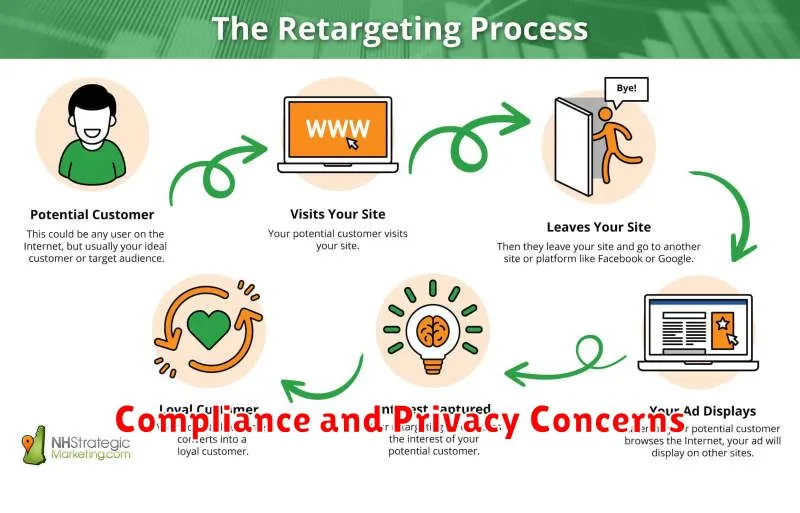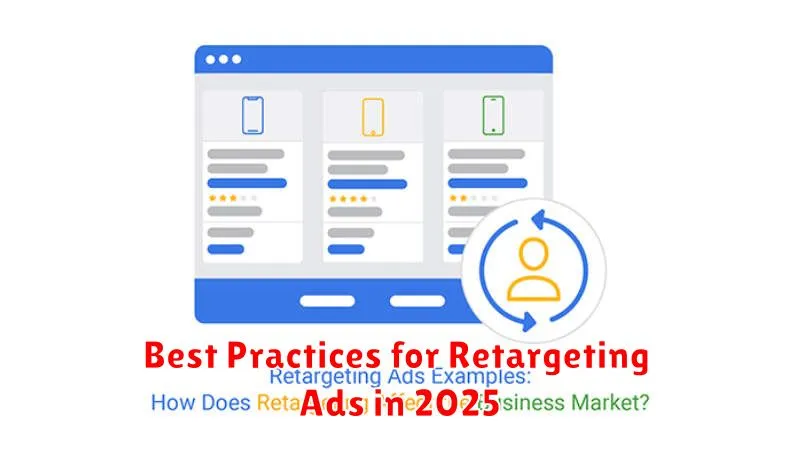In the ever-evolving digital marketing landscape, retargeting ads remain a powerful tool for re-engaging potential customers and driving conversions. As we move into 2025, understanding and implementing the best practices for retargeting is more crucial than ever. This article will explore the most effective strategies to optimize your retargeting campaigns, maximize your return on investment (ROI), and achieve your marketing objectives. We will delve into audience segmentation, ad creative optimization, frequency capping, and the latest trends shaping the future of retargeting, including the impact of privacy changes and the rise of cookieless solutions.
Mastering the art of retargeting requires a strategic approach that goes beyond simply showing ads to past website visitors. This guide will equip you with the knowledge and insights needed to create highly effective retargeting campaigns that deliver personalized experiences, resonate with your target audience, and ultimately drive meaningful results in 2025. From leveraging dynamic retargeting to implementing cross-channel strategies and understanding the nuances of platform-specific best practices, this article will provide a comprehensive roadmap for success in the competitive world of retargeting advertising.
What Is Retargeting and Why Use It?
Retargeting, also known as remarketing, is a powerful digital marketing strategy that allows you to reconnect with users who have previously interacted with your website or app. It works by displaying targeted ads to these individuals as they browse other websites, use social media, or engage with other online platforms. Essentially, retargeting allows you to re-engage with potential customers who have shown initial interest but haven’t yet converted, reminding them of your products or services and encouraging them to return to your site.
The primary benefit of retargeting lies in its ability to increase conversions. By specifically targeting individuals who are already familiar with your brand, you significantly improve the likelihood of converting them into paying customers. These individuals have already demonstrated some level of interest, placing them further down the sales funnel than a completely new audience. Retargeting helps nurture these leads by keeping your brand top-of-mind and providing additional opportunities for engagement.
Furthermore, retargeting offers valuable insights into consumer behavior. By analyzing user interactions with your retargeting campaigns, you can gain a better understanding of what resonates with your target audience. This data can then be used to refine your marketing strategies, optimize your website content, and personalize the user experience, ultimately leading to improved ROI.
Types of Retargeting Campaigns
Site-based retargeting is the most common type. It focuses on users who have visited your website but didn’t complete a desired action, such as making a purchase or filling out a form. By tracking these users through cookies, you can display targeted ads reminding them of the products they viewed or offering incentives to encourage a return visit and conversion.
Search retargeting targets users who have recently searched for keywords related to your products or services, even if they haven’t visited your website. This approach allows you to reach a broader audience interested in what you offer, capturing potential customers who are actively searching for solutions you provide.
Email retargeting re-engages users who have interacted with your emails but haven’t taken the next step. This can involve sending targeted emails to users who abandoned their shopping cart, reminding them of items left behind, or promoting related products based on their browsing history or previous purchases. This method allows for personalized messaging and can effectively nurture leads towards conversion.
Setting Up Tracking Pixels Correctly
Tracking pixels are powerful tools for understanding user behavior and optimizing online advertising campaigns. Proper implementation is crucial for accurate data collection and analysis. Begin by identifying the specific pixel you need based on the platform you’re using (e.g., Facebook Pixel, Google Ads Conversion Tracking). Then, carefully follow the platform’s instructions for generating the pixel code. This usually involves creating a pixel within the platform’s interface and copying the provided code snippet.
Placement of the pixel code is equally important. The pixel should be placed within the section of every page you want to track. This ensures the pixel loads early and captures all relevant user interactions. Ensure the code is placed within the opening and closing tags. For specific conversion events, such as purchases or form submissions, the pixel code might need additional parameters or placement on a confirmation page to accurately attribute the conversion.
After implementation, thoroughly test the pixel functionality. Use the platform’s debugging tools or a browser’s developer tools to verify the pixel is firing correctly and transmitting data. Monitor the data collected within the respective platform to ensure accuracy and identify any discrepancies. Regular testing and adjustments are essential to maintain accurate tracking and optimize campaign performance.
Segmenting Audiences Effectively

Audience segmentation is the process of dividing a broad consumer market into smaller, more homogenous groups based on shared characteristics. This allows businesses to tailor their marketing efforts to specific subsets of their audience, increasing the effectiveness of campaigns and maximizing return on investment. By understanding the unique needs, preferences, and behaviors of different segments, businesses can create more relevant and engaging content, ultimately driving stronger connections and fostering customer loyalty.
Several key factors are considered when segmenting audiences. Demographics like age, gender, location, and income level provide a foundational understanding of the target market. Psychographics delve deeper into consumers’ values, lifestyles, interests, and attitudes. Behavioral segmentation focuses on past purchase history, browsing behavior, and product usage. By combining these factors, businesses can create detailed profiles of their ideal customers, enabling more precise targeting and personalized messaging.
Effective audience segmentation offers numerous benefits. It enhances campaign performance by ensuring that marketing messages reach the most receptive individuals. It improves resource allocation by focusing efforts on the most promising segments. It facilitates the development of targeted products and services that cater to the specific needs of different customer groups. Ultimately, successful segmentation leads to increased customer engagement, higher conversion rates, and a stronger bottom line.
Creating Personalized Ad Experiences
Personalized advertising tailors ad content to individual users based on their interests, demographics, and online behavior. This approach aims to deliver more relevant and engaging ads, increasing the likelihood of user interaction and conversion. Data sources used for personalization can include browsing history, search queries, social media activity, and purchase history. By understanding user preferences, advertisers can present products and services that are more likely to resonate with them, leading to a more positive user experience and improved campaign performance.
The benefits of personalized ads extend to both users and advertisers. Users are more likely to see ads for products and services they actually need or want, reducing the annoyance factor often associated with generic advertising. For advertisers, personalization allows for efficient ad spending by targeting the right audience, maximizing return on investment, and improving key metrics like click-through rates and conversion rates. It also allows for more precise campaign measurement and optimization, enabling businesses to refine their targeting strategies and further improve ad effectiveness.
While personalization offers significant advantages, it also raises privacy concerns. It’s crucial for advertisers to prioritize data privacy and transparency. Users should be informed about how their data is being collected and used, and given the opportunity to control their privacy settings. Adherence to relevant data privacy regulations and industry best practices is essential for building and maintaining user trust. By balancing personalization with responsible data handling, advertisers can create ad experiences that are both effective and respectful of user privacy.
Timing and Frequency Control
Timing and frequency control are crucial aspects of many systems, ensuring accurate and synchronized operations. Timing control refers to the precise scheduling and execution of events, dictating when specific actions occur. Frequency control, on the other hand, governs the rate at which cyclical processes repeat, maintaining a stable and desired rate of oscillation or repetition.
These concepts are fundamental in diverse fields. For example, in digital electronics, clock signals provide precise timing for operations within a circuit. In telecommunications, frequency synchronization prevents interference and ensures clear communication. Furthermore, power systems rely on frequency control to maintain grid stability and prevent blackouts.
Applications requiring precise timing and frequency control include:
- Data synchronization
- Instrumentation and measurement
- Industrial automation
- Audio and video processing
Ad Design That Converts
Creating high-converting ads requires a blend of compelling visuals and persuasive messaging. Start with a clear understanding of your target audience. What are their needs and pain points? What motivates them? Use this knowledge to craft ad copy that speaks directly to their desires and offers a compelling solution. Visually, your ad should be eye-catching and instantly communicate the value proposition. A strong call to action is crucial, telling viewers exactly what you want them to do.
Consider the platform where your ad will be displayed. Different platforms have different design requirements and best practices. For example, a video ad on YouTube will have different specifications than a static image ad on Facebook. Optimize your design accordingly to maximize its impact and ensure it renders correctly. Testing is also essential. Experiment with different versions of your ad to see what resonates best with your audience. Analyze the results and make adjustments to improve performance.
Key elements for success include a strong headline that grabs attention, high-quality images or videos that are relevant to your product or service, and concise, benefit-driven copy. Keep it simple, focus on the value you provide, and make it easy for viewers to take action.
Avoiding Ad Fatigue
Ad fatigue occurs when your target audience is overexposed to your advertisements, leading to decreased engagement and ultimately, a lower return on investment. Frequency and relevance are key factors contributing to this phenomenon. Seeing the same ad repeatedly can irritate viewers, causing them to tune out or even develop negative associations with your brand. Similarly, irrelevant ads fail to capture attention and can be perceived as intrusive.
To combat ad fatigue, implement a diverse ad strategy. This includes creating variations of your ad creatives with different messaging, visuals, and calls to action. A/B testing is crucial for identifying which variations resonate best with your audience. Regularly refreshing your ad creatives keeps your campaigns engaging and prevents viewers from becoming desensitized. Consider also implementing frequency capping, which limits the number of times a single user sees your ad within a specific timeframe. This helps maintain a balance between visibility and overexposure.
Targeting the right audience is equally vital. Refine your targeting parameters to ensure your ads are reaching users genuinely interested in your products or services. Utilize platform-specific targeting options based on demographics, interests, and behaviors. This focused approach minimizes wasted ad spend and maximizes the chances of reaching receptive individuals. Finally, explore different ad formats and platforms to diversify your reach and engage users in novel ways.
Analyzing CTR and ROI
Click-Through Rate (CTR) and Return on Investment (ROI) are crucial metrics for evaluating the effectiveness of marketing campaigns. CTR measures the percentage of people who click on an ad or link after seeing it, indicating audience engagement. A higher CTR suggests a more compelling ad or more accurately targeted audience. ROI, on the other hand, measures the profitability of an investment relative to its cost. Calculating ROI involves comparing the revenue generated from a campaign against the expenses incurred.
Analyzing CTR and ROI together provides a comprehensive understanding of campaign performance. A high CTR doesn’t necessarily guarantee a high ROI. For instance, a campaign might generate many clicks (high CTR) but not lead to conversions or sales (low ROI). Conversely, a lower CTR could still yield a high ROI if the clicks convert into high-value customers. Therefore, it’s essential to consider both metrics in conjunction to optimize campaign strategy.
By monitoring and analyzing CTR and ROI, marketers can identify areas for improvement. Low CTR might indicate a need to refine targeting, ad copy, or creative elements. Low ROI, despite a decent CTR, could suggest issues with the landing page, sales funnel, or pricing strategy. Regularly assessing these metrics allows for data-driven adjustments, ultimately leading to more effective and profitable campaigns.
Compliance and Privacy Concerns

Compliance with data privacy regulations is crucial for organizations handling personal information. These regulations, such as GDPR, CCPA, and HIPAA, establish strict rules for data collection, storage, processing, and transfer. Failure to comply can result in significant fines and reputational damage. Organizations must implement robust data governance frameworks, conduct regular audits, and provide transparency to users about how their data is being used.
Privacy concerns are paramount in today’s digital landscape. Individuals are increasingly aware of the potential risks associated with sharing their personal information online. Data breaches, unauthorized access, and misuse of data can have serious consequences, including identity theft, financial loss, and emotional distress. Organizations must prioritize data security and implement appropriate safeguards to protect user data.
Addressing compliance and privacy concerns requires a multifaceted approach. This includes implementing technical measures such as encryption and access controls, establishing clear policies and procedures, providing training to employees, and fostering a culture of data protection. By prioritizing compliance and privacy, organizations can build trust with users and demonstrate their commitment to responsible data handling.

